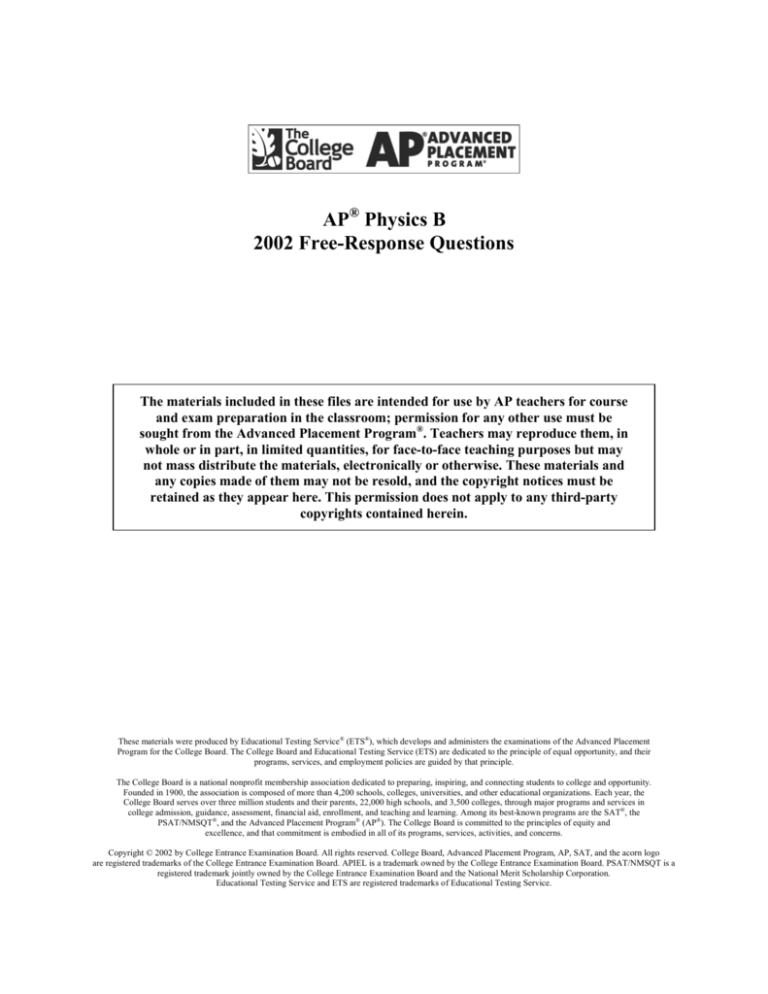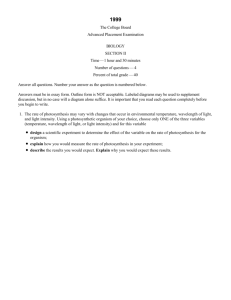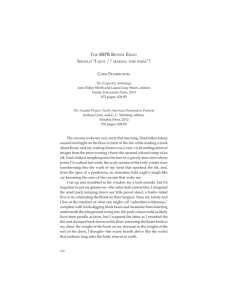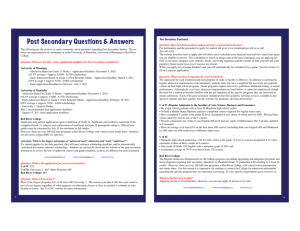
$3Physics B
)UHH5HVSRQVH4XHVWLRQV
7KHPDWHULDOVLQFOXGHGLQWKHVHILOHVDUHLQWHQGHGIRUXVHE\$3WHDFKHUVIRUFRXUVH
DQGH[DPSUHSDUDWLRQLQWKHFODVVURRPSHUPLVVLRQIRUDQ\RWKHUXVHPXVWEH
VRXJKWIURPWKH$GYDQFHG3ODFHPHQW3URJUDP7HDFKHUVPD\UHSURGXFHWKHPLQ
ZKROHRULQSDUWLQOLPLWHGTXDQWLWLHVIRUIDFHWRIDFHWHDFKLQJSXUSRVHVEXWPD\
QRWPDVVGLVWULEXWHWKHPDWHULDOVHOHFWURQLFDOO\RURWKHUZLVH7KHVHPDWHULDOVDQG
DQ\FRSLHVPDGHRIWKHPPD\QRWEHUHVROGDQGWKHFRS\ULJKWQRWLFHVPXVWEH
UHWDLQHGDVWKH\DSSHDUKHUH7KLVSHUPLVVLRQGRHVQRWDSSO\WRDQ\WKLUGSDUW\
FRS\ULJKWVFRQWDLQHGKHUHLQ
7KHVHPDWHULDOVZHUHSURGXFHGE\(GXFDWLRQDO7HVWLQJ6HUYLFH (76ZKLFKGHYHORSVDQGDGPLQLVWHUVWKHH[DPLQDWLRQVRIWKH$GYDQFHG3ODFHPHQW
3URJUDPIRUWKH&ROOHJH%RDUG7KH&ROOHJH%RDUGDQG(GXFDWLRQDO7HVWLQJ6HUYLFH(76DUHGHGLFDWHGWRWKHSULQFLSOHRIHTXDORSSRUWXQLW\DQGWKHLU
SURJUDPVVHUYLFHVDQGHPSOR\PHQWSROLFLHVDUHJXLGHGE\WKDWSULQFLSOH
7KH&ROOHJH%RDUGLVDQDWLRQDOQRQSURILWPHPEHUVKLSDVVRFLDWLRQGHGLFDWHGWRSUHSDULQJLQVSLULQJDQGFRQQHFWLQJVWXGHQWVWRFROOHJHDQGRSSRUWXQLW\
)RXQGHGLQWKHDVVRFLDWLRQLVFRPSRVHGRIPRUHWKDQVFKRROVFROOHJHVXQLYHUVLWLHVDQGRWKHUHGXFDWLRQDORUJDQL]DWLRQV(DFK\HDUWKH
&ROOHJH%RDUGVHUYHVRYHUWKUHHPLOOLRQVWXGHQWVDQGWKHLUSDUHQWVKLJKVFKRROVDQGFROOHJHVWKURXJKPDMRUSURJUDPVDQGVHUYLFHVLQ
FROOHJHDGPLVVLRQJXLGDQFHDVVHVVPHQWILQDQFLDODLGHQUROOPHQWDQGWHDFKLQJDQGOHDUQLQJ$PRQJLWVEHVWNQRZQSURJUDPVDUHWKH6$7WKH
36$710647DQGWKH$GYDQFHG3ODFHPHQW3URJUDP$37KH&ROOHJH%RDUGLVFRPPLWWHGWRWKHSULQFLSOHVRIHTXLW\DQG
H[FHOOHQFHDQGWKDWFRPPLWPHQWLVHPERGLHGLQDOORILWVSURJUDPVVHUYLFHVDFWLYLWLHVDQGFRQFHUQV
&RS\ULJKWE\&ROOHJH(QWUDQFH([DPLQDWLRQ%RDUG$OOULJKWVUHVHUYHG&ROOHJH%RDUG$GYDQFHG3ODFHPHQW3URJUDP$36$7DQGWKHDFRUQORJR
DUHUHJLVWHUHGWUDGHPDUNVRIWKH&ROOHJH(QWUDQFH([DPLQDWLRQ%RDUG$3,(/LVDWUDGHPDUNRZQHGE\WKH&ROOHJH(QWUDQFH([DPLQDWLRQ%RDUG36$710647LVD
UHJLVWHUHGWUDGHPDUNMRLQWO\RZQHGE\WKH&ROOHJH(QWUDQFH([DPLQDWLRQ%RDUGDQGWKH1DWLRQDO0HULW6FKRODUVKLS&RUSRUDWLRQ
(GXFDWLRQDO7HVWLQJ6HUYLFHDQG(76DUHUHJLVWHUHGWUDGHPDUNVRI(GXFDWLRQDO7HVWLQJ6HUYLFH
TABLE OF INFORMATION FOR 2002
UNITS
CONSTANTS AND CONVERSION FACTORS
1 unified atomic mass unit,
1 u = 1.66 10
-27
= 931 MeV/c
Proton mass,
PREFIXES
Name
Symbol
meter
kilogram
Factor
Prefix
Symbol
m
10 9
giga
G
kg
10
6
mega
M
10
3
kilo
k
kg
2
m p = 1.67 × 10 −27 kg
Neutron mass,
mn = 1.67 × 10 −27 kg
second
s
Electron mass,
me = 9.11 × 10 −31 kg
ampere
A
10 −2
centi
c
Magnitude of the electron charge,
e = 1.60 × 10 −19 C
kelvin
K
10 −3
milli
m
micro
µ
Avogadro’s number,
Universal gas constant,
N0 = 6.02 × 10 mol
23
−1
R = 8.31 J / ( mol ¼ K )
mole
mol
hertz
Hz
10 −9
nano
n
10 −12
pico
p
Boltzmann’s constant,
k B = 1.38 × 10 −23 J / K
Speed of light,
c = 3.00 × 10 8 m / s
newton
N
Planck’s constant,
h = 6.63 × 10 −34 J ⋅ s
pascal
Pa
= 4.14 × 10 −15 eV ⋅ s
hc = 1.99 × 10 −25 J ⋅ m
= 1.24 × 10 3 eV ⋅ nm
Vacuum permittivity,
Coulomb’s law constant,
Vacuum permeability,
Magnetic constant,
Universal gravitational constant,
Acceleration due to gravity
at the Earth’s surface,
1 atmosphere pressure,
⑀ 0 = 8.85 × 10
−12
C / N⋅m
2
2
k = 1 / 4π ⑀ 0 = 9.0 × 10 N ⋅ m 2 / C 2
9
µ 0 = 4π × 10 −7 (T ⋅ m ) / A
k = µ 0 / 4π = 10 (T ⋅ m ) / A
−7
G
= 6.67 10 -11 m 3 / kg ¼ s 2
g = 9.8 m / s
2
1 atm = 1.0 × 10 5 N / m 2
= 1.0 × 10 Pa
10
−6
VALUES OF TRIGONOMETRIC FUNCTIONS
FOR COMMON ANGLES
joule
J
watt
W
θ
coulomb
C
0
volt
V
ohm
Ω
henry
H
farad
F
tesla
T
45o
o
sin θ
cos θ
tan θ
0
1
0
3 /2
3 /3
30o
1/2
37o
3/5
degree
Celsius
o
C
53o
electronvolt
eV
60o
90o
2 /2
4/5
4/5
2 /2
3/4
1
3/5
4/3
3 /2
1/2
3
1
0
∞
5
1 electron volt,
1 eV = 1.60 × 10 −19 J
The following conventions are used in this examination.
I. Unless otherwise stated, the frame of reference of any problem is assumed to be inertial.
II. The direction of any electric current is the direction of flow of positive charge (conventional current).
III. For any isolated electric charge, the electric potential is defined as zero at an infinite distance from the
charge.
IV. For mechanics and thermodynamics equations, W represents the work done on a system.
2
ADVANCED PLACEMENT PHYSICS B EQUATIONS FOR 2002
NEWTONIAN MECHANICS
u = u 0 + at
1 2
at
2
x = x0 + u0 t +
0
u 2 = u 0 2 + 2a x - x 0
5
Ê F = Fnet = ma
F fric mN
ac =
u2
r
t = rF sin q
p = mv
J = FDt =
Dp
1
mu 2
2
K =
DUg = mgh
W = F ⴢ Dr = FDr cos q
Pavg =
W
Dt
P = F ⴢ v = Fu cos q
Fs = - k x
1 2
kx
2
Us =
m
Ts = 2 p
k
Tp = 2 p
T =
1
f
FG = UG
l
g
a =
F =
f =
h =
J =
K =
k =
l =
m=
N =
P =
p =
r =
r =
T =
t =
U=
u =
W=
x =
m=
q =
t =
acceleration
force
frequency
height
impulse
kinetic energy
spring constant
length
mass
normal force
power
momentum
radius or distance
position vector
period
time
potential energy
velocity or speed
work done on a system
position
coefficient of friction
angle
torque
ELECTRICITY AND MAGNETISM
F=
1 q1 q 2
4 p⑀ 0 r 2
E=
F
q
UE = qV =
E avg = −
V=
r2
Gm1m2
= r
1 q1 q 2
4 p⑀ 0 r
V
d
qi
1
4 p⑀ 0
∑r
i
i
Q
V
⑀ A
C= 0
d
1
1
Uc = QV = CV 2
2
2
C=
I avg =
DQ
Dt
ρl
A
V = IR
P = IV
R=
C p = ∑ Ci
i
1
1
=∑
Cs
i Ci
Rs = ∑ Ri
i
1
1
=∑
Rp
i Ri
FB = qu B sin θ
FB = BIl sin θ
B=
Gm1m2
A
B
C
d
E
m0 I
2p r
fm = B • A = BA cos θ
eavg = −
e = Blu
3
Dfm
Dt
=
=
=
=
=
=
=
=
=
=
=
=
=
=
=
=
=
area
magnetic field
capacitance
distance
electric field
e emf
F
force
I
current
l
length
P
power
Q charge
q
point charge
R
resistance
r
distance
t
time
U potential (stored) energy
V
electric potential or
potential difference
u = velocity or speed
r = resistivity
fm = magnetic flux
ADVANCED PLACEMENT PHYSICS B EQUATIONS FOR 2002
FLUID MECHANICS AND
WAVES AND OPTICS
THERMAL PHYSICS
p = p0 + rgh
Fbuoy = rVg
A1u1 = A2 u 2
1
p + rgy + ru 2 = const.
2
D l = a l 0 DT
Q = mL
Q = mcDT
p =
F
A
pV = nRT
3
k T
2 B
K avg =
3 RT
=
M
u rms =
W = - pDV
Q = ncDT
DU = Q + W
DU = ncV DT
e =
ec =
3k B T
m
A = area
c = specific heat or molar
specific heat
e = efficiency
F = force
h = depth
Kavg = average molecular
kinetic energy
L = heat of transformation
l = length
M = molecular mass
m = mass of sample
n = number of moles
p = pressure
Q = heat transferred to a system
T = temperature
U = internal energy
V = volume
u = velocity or speed
urms = root-mean-square
velocity
W = work done on a system
y = height
a = coefficient of linear
expansion
µ = mass of molecule
r = density
W
QH
TH - TC
TH
ATOMIC AND NUCLEAR PHYSICS
E = hf = pc
Kmax = hf − f
l =
h
p
DE = ( Dm) c 2
E
f
K
m
p
l
f
=
=
=
=
=
=
=
energy
frequency
kinetic energy
mass
momentum
wavelength
work function
4
u = fl
c
n =
u
n 1 sin q1 = n 2 sin q 2
sin q c =
n2
n1
1
1
1
+
=
si
s0
f
h
s
M = i = - i
s0
h0
R
2
d sin q = ml
f =
xm ⬇
d = separation
f = frequency or focal
length
h = height
L = distance
M = magnification
m = an integer
n = index of refraction
R = radius of curvature
s = distance
u = speed
x = position
l = wavelength
q = angle
ml L
d
GEOMETRY AND TRIGONOMETRY
Rectangle
A = bh
Triangle
1
A = bh
2
Circle
A = pr 2
C = 2 pr
Parallelepiped
V = lwh
Cylinder
V = pr 2 l
S = 2 pr l + 2 pr 2
Sphere
4
V = pr 3
3
S = 4 pr 2
Right Triangle
a 2 + b2 = c2
a
sin q =
c
b
cos q = c
a
tan q = b
A=
C=
V=
S =
b =
h =
l =
w=
r =
area
circumference
volume
surface area
base
height
length
width
radius
c
q
a
90
b
2002 AP® PHYSICS B FREE-RESPONSE QUESTIONS
PHYSICS B
SECTION II
Time—90 minutes
7 Questions
Directions: Answer all seven questions, which are weighted according to the points indicated. The suggested time
is about 15 minutes for answering each of questions 1-4, and about 10 minutes for answering each of questions 5-7.
The parts within a question may not have equal weight. Show all your work in the pink booklet in the spaces
provided after each part, NOT in this green insert.
1. (15 points)
A model rocket of mass 0.250 kg is launched vertically with an engine that is ignited at time t = 0, as shown
above. The engine provides an impulse of 20.0 N s by firing for 2.0 s. Upon reaching its maximum height, the
rocket deploys a parachute, and then descends vertically to the ground.
(a) On the figures below, draw and label a free-body diagram for the rocket during each of the following
intervals.
i. While the engine
is firing
ii. After the engine stops,
but before the parachute
is deployed
iii. After the parachute is
deployed
(b) Determine the magnitude of the average acceleration of the rocket during the 2 s firing of the engine.
(c) What maximum height will the rocket reach?
(d) At what time after t = 0 will the maximum height be reached?
Copyright © 2002 by College Entrance Examination Board. All rights reserved.
Advanced Placement Program and AP are registered trademarks of the College Entrance Examination Board.
5
GO ON TO THE NEXT PAGE.
2002 AP® PHYSICS B FREE-RESPONSE QUESTIONS
2. (15 points)
A 3.0 kg object subject to a restoring force F is undergoing simple harmonic motion with a small amplitude.
The potential energy U of the object as a function of distance x from its equilibrium position is shown above.
This particular object has a total energy E of 0.4 J.
(a) What is the object’s potential energy when its displacement is +4 cm from its equilibrium position?
(b) What is the farthest the object moves along the x-axis in the positive direction? Explain your reasoning.
(c) Determine the object’s kinetic energy when its displacement is –7 cm.
(d) What is the object’s speed at x = 0 ?
(e) Suppose the object undergoes this motion because it is the bob of a simple pendulum as shown above. If the
object breaks loose from the string at the instant the pendulum reaches its lowest point and hits the ground at
point P shown, what is the horizontal distance d that it travels?
Copyright © 2002 by College Entrance Examination Board. All rights reserved.
Advanced Placement Program and AP are registered trademarks of the College Entrance Examination Board.
6
GO ON TO THE NEXT PAGE.
2002 AP® PHYSICS B FREE-RESPONSE QUESTIONS
3. (15 points)
Two lightbulbs, one rated 30 W at 120 V and another rated 40 W at 120 V, are arranged in two
different circuits.
(a) The two bulbs are first connected in parallel to a 120 V source.
i. Determine the resistance of the bulb rated 30 W and the current in it when it is connected
in this circuit.
ii. Determine the resistance of the bulb rated 40 W and the current in it when it is connected in
this circuit.
(b) The bulbs are now connected in series with each other and a 120 V source.
i. Determine the resistance of the bulb rated 30 W and the current in it when it is connected in
this circuit.
ii. Determine the resistance of the bulb rated 40 W and the current in it when it is connected in
this circuit.
(c) In the spaces below, number the bulbs in each situation described, in order of their brightness.
(1 = brightest, 4 = dimmest)
____30 W bulb in the parallel circuit
____40 W bulb in the parallel circuit
____30 W bulb in the series circuit
____40 W bulb in the series circuit
(d) Calculate the total power dissipated by the two bulbs in each of the following cases.
i. The parallel circuit
ii. The series circuit
Copyright © 2002 by College Entrance Examination Board. All rights reserved.
Advanced Placement Program and AP are registered trademarks of the College Entrance Examination Board.
7
GO ON TO THE NEXT PAGE.
2002 AP® PHYSICS B FREE-RESPONSE QUESTIONS
4. (15 points)
A thin converging lens of focal length 10 cm is used as a simple magnifier to examine an object A that is held
6 cm from the lens.
(a) On the figure below, draw a ray diagram showing the position and size of the image formed.
(b) State whether the image is real or virtual. Explain your reasoning.
(c) Calculate the distance of the image from the center of the lens.
(d) Calculate the ratio of the image size to the object size.
(e) The object A is now moved to the right from x = 6 cm to a position of x = 20 cm, as shown above. Describe
the image position, size, and orientation when the object is at x = 20 cm.
Copyright © 2002 by College Entrance Examination Board. All rights reserved.
Advanced Placement Program and AP are registered trademarks of the College Entrance Examination Board.
8
GO ON TO THE NEXT PAGE.
2002 AP® PHYSICS B FREE-RESPONSE QUESTIONS
5. (10 points)
A proton of mass mp and charge e is in a box that contains an electric field E, and the box is located in Earth’s
magnetic field BEarth. The proton moves with an initial velocity v vertically upward from the surface
of Earth. Assume gravity is negligible.
(a) On the diagram above, indicate the direction of the electric field inside the box so that there is no change in
the trajectory of the proton while it moves upward in the box. Explain your reasoning.
(b) Determine the speed of the proton while in the box if it continues to move vertically upward. Express your
answer in terms of the fields and the given quantities.
The proton now exits the box through the opening at the top.
(c) On the figure on the previous page, sketch the path of the proton after it leaves the box.
(d) Determine the magnitude of the acceleration a of the proton just after it leaves the box, in terms of the given
quantities and fundamental constants.
Copyright © 2002 by College Entrance Examination Board. All rights reserved.
Advanced Placement Program and AP are registered trademarks of the College Entrance Examination Board.
9
GO ON TO THE NEXT PAGE.
2002 AP® PHYSICS B FREE-RESPONSE QUESTIONS
6. (10 points)
In the laboratory, you are given a cylindrical beaker containing a fluid and you are asked to determine the
density r of the fluid. You are to use a spring of negligible mass and unknown spring constant k attached to a
stand. An irregularly shaped object of known mass m and density D (D >> r) hangs from the spring. You may
also choose from among the following items to complete the task.
• A metric ruler
• A stopwatch
• String
(a) Explain how you could experimentally determine the spring constant k.
(b) The spring-object system is now arranged so that the object (but none of the spring) is immersed in the
unknown fluid, as shown above. Describe any changes that are observed in the spring-object system and
explain why they occur.
(c) Explain how you could experimentally determine the density of the fluid.
(d) Show explicitly, using equations, how you will use your measurements to calculate the fluid density r. Start
by identifying any symbols you use in your equations.
Symbol
Physical quantity
Copyright © 2002 by College Entrance Examination Board. All rights reserved.
Advanced Placement Program and AP are registered trademarks of the College Entrance Examination Board.
10
GO ON TO THE NEXT PAGE.
2002 AP® PHYSICS B FREE-RESPONSE QUESTIONS
7. (10 points)
A photon of wavelength 2.0 × 10 −11 m strikes a free electron of mass me that is initially at rest, as shown above
left. After the collision, the photon is shifted in wavelength by an amount Dl = 2h me c , and reversed
in direction, as shown above right.
(a) Determine the energy in joules of the incident photon.
(b) Determine the magnitude of the momentum of the incident photon.
(c) Indicate below whether the photon wavelength is increased or decreased by the interaction.
____Increased
____Decreased
Explain your reasoning.
(d) Determine the magnitude of the momentum acquired by the electron.
END OF EXAMINATION
Copyright © 2002 by College Entrance Examination Board. All rights reserved.
Advanced Placement Program and AP are registered trademarks of the College Entrance Examination Board.
11









